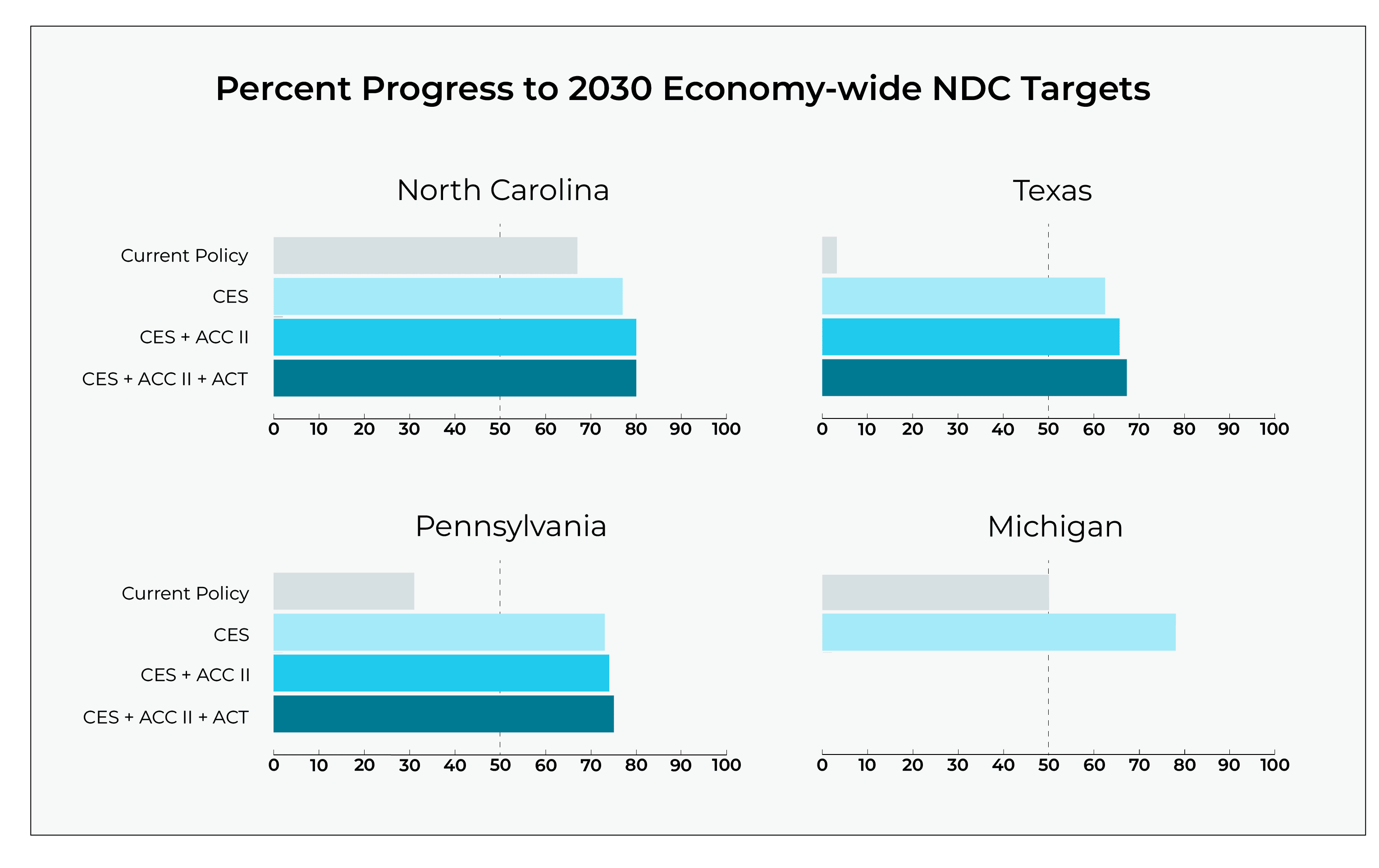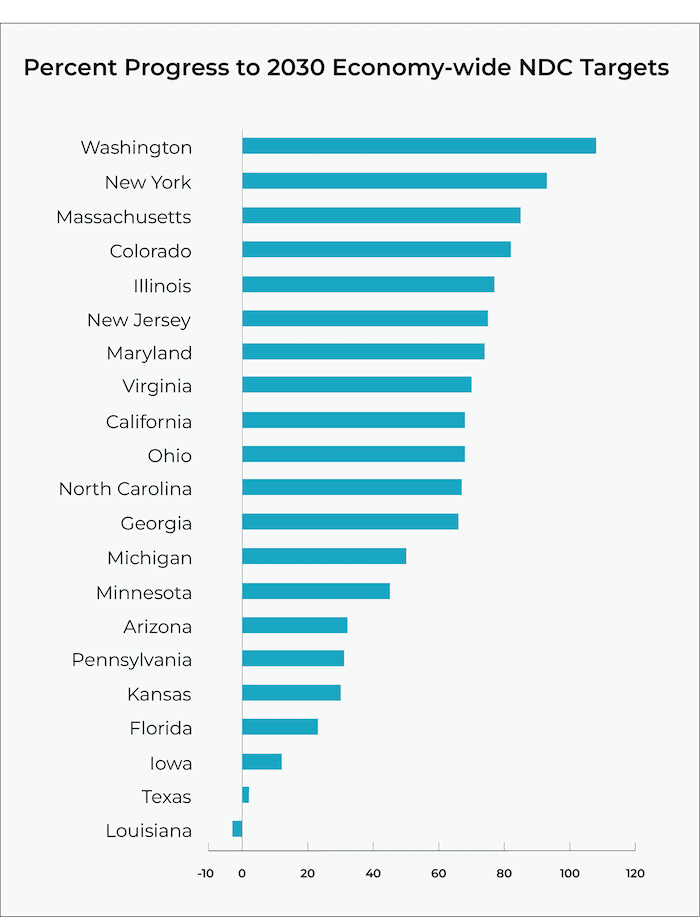Author
Ruby Wincele ǀ Policy & Research Manager
Editors
Greg Casto ǀ Senior Communications Associate
Amanda Pontillo ǀ Communications Director & Operations Lead
Jonah Kurman-Faber ǀ Policy & Research Director
2023 has seen monumental progress in climate policy, with states enacting high–impact climate policies and playing a crucial role in implementing billions of federal climate dollars. As many policymakers and advocates begin to turn their attention to 2024, it’s important to take stock of the progress states have made so far, and identify high impact priorities for future action.
To aid this effort, Climate XChange partnered with RMI to develop 20 State Climate Scorecards to analyze how states are progressing toward climate-aligned targets and pinpoint gaps in policy to further reduce emissions.
Key Results
Important note – these projections are tied to goals aligned with the UN’s Nationally Determined Contributions (NDCs), not any mandatory or voluntary targets set by state governments. The Scorecards use a target of state-specific NDC-aligned goals, which if met collectively, would allow the U.S. to be on track to achieve a 50 percent reduction in greenhouse gas emissions below 2005 levels by 2030.
- Washington is the only state projected to reach an NDC-aligned economy-wide target by 2030 with its current set of policies. Other climate leaders such as New York, Massachusetts, and Colorado will be close to 2030 NDC-aligned goals, but need additional actions to get there. The remaining 16 Scorecard states, half of which are less than halfway to 2030 NDC-aligned emissions goals, need ambitious policies to close these gaps. Read more about the results here.
- The majority of progress comes from a few key foundational policies — namely clean energy standards and electric vehicle (EV) sales mandates — as well as the attractive economics driving adoption of renewables, EVs, and electric appliances.
- Many states can benefit from adopting these foundational policies. We found North Carolina, Pennsylvania, and Texas can experience large leaps in their climate progress just from enacting three policies: an 80 percent clean energy standard by 2030, Advanced Clean Cars II, and Advanced Clean Trucks.
What is driving progress?
The Scorecards provide sector-specific targets for emissions and technology adoption to identify existing policy gaps and measure economy-wide progress towards NDC-aligned goals. Overall, the most successful Scorecard states are on track to meet climate-aligned targets through emissions reductions in the electricity and transportation sectors. For states that need to catch up, there are a handful of policies that are driving this progress. Market forces are also at play in reducing emissions.
Foundational policies
Foundational policies such as clean energy standards (CES) and renewable portfolio standards (RPS), EV sales standards, and building energy codes provide a foundation for most state emissions reductions.
CESs/RPSs, which mandate a certain percentage of electricity to come from clean or renewable energy sources, are cleaning up states’ energy mixes and driving down electricity emissions. States with strong 2030 standards of at least 80 percent clean electricity are projected to make the most progress toward the electricity sector NDC-aligned targets, including Massachusetts, Washington, and Illinois.
Another set of standards, known as Advanced Clean Cars II (ACC II) for light-duty vehicles and Advanced Clean Trucks (ACT) for medium- and heavy-duty trucks, are driving forces behind progress in the transportation sector. The four Scorecard states that have adopted both ACC II and ACT (Massachusetts, New York, Virginia, and Washington), which phase out gasoline and diesel-powered vehicle sales by 2035 and 2045, respectively, are projected to see some of the greatest reductions in transportation emissions by 2030.
Updating building energy codes is a foundational policy tactic that can help tackle buildings emissions, which account for 34 percent of the country’s emissions. They establish a baseline increase in energy efficiency in newly constructed buildings and modest emissions reductions. Louisiana, for example, enacted HB 803 in 2022 to update the state’s residential and commercial building codes to the 2021 International Energy Conservation Code (IECC), which will help the state get to nearly 40 percent of its 2030 building sector greenhouse gas (GHG) target.
Broad policy coverage
Leading Scorecard states show that economy-wide policy coverage is crucial for meeting climate goals. For example, Washington, the only state on track to meet the economy-wide NDC target by 2030, has an economy-wide cap-and-invest program. States like Massachusetts, Maryland, and Colorado, which are not too far behind meeting the NDC-aligned goals, have broad reaching policy coverage across sectors, including a slew of clean technology incentives, sales standards, and grant programs.
Market forces
With the costs of climate-friendly technologies continuing to plummet, we’re seeing more widespread adoption of renewables and EVs, as well as energy-efficient building technologies like heat pumps and electric appliances. In addition to foundational policies, these market forces are playing a key role in states making progress towards electricity and transportation metrics. They also enable states that lack many climate policies to still make some progress towards NDC-aligned goals.
For example, Georgia and Louisiana — two states without statewide transportation policies — will be 66 and 75 percent of the way towards meeting their transportation emissions goals by 2030, respectively, and have already made significant progress to date. Even without statewide transportation policies, both states will have more than half of the targeted number of EVs on the road by 2030.
Early retirement of uneconomic coal plants play a key role in cleaning up the electricity grid and meeting electricity metrics. Georgia, for example, is retiring nearly 2,500 MW of additional coal generation in the next five years, which will help the state reach 73 percent of its electricity GHG target by 2030. With all of its expected coal plant retirements, Georgia will be on track to retire 71 percent of its remaining coal generation capacity by 2030. Kansas is retiring three additional coal plants in the next decade — 1,905 MW of coal generation capacity in the next decade. These retirements, as well as being a national leader in wind energy deployment, will get the state nearly halfway to its wind and solar capacity and electricity GHG targets by 2030.
Innovative sector-specific solutions
Although we found that market forces and foundational policies achieve the majority of emissions reductions, states can’t rely on these solutions alone to meet 2030 NDC-aligned goals. States need more targeted approaches for certain areas where they are lagging behind, including building heating and cooling emissions, as well as methane emissions from oil and gas production.
Leading states have enacted innovative policies to help close these gaps, such as Maryland’s building performance standard and Washington’s building code that requires heat pumps in new residential and commercial construction. Policies that require gas utilities to reduce emissions, such as S.9 in Massachusetts and SB 21-264 in Colorado, drive gains in energy efficiency and electric appliance adoption.
To address industrial methane emissions, Colorado adopted nation-leading regulations that target oil and gas operations. Its emissions intensity program requires operators to reduce emissions by set percentages based on the amount of oil and gas they produce, and other rules require more frequent leak detection and repair (LDAR), ban routine methane venting and flaring, and require operators to install technology to limit or prevent emissions. By 2030, Colorado is expected to reduce oil and gas methane emissions 36.8 percent, relative to 2021 levels.
Case Studies: Adopting Foundational Policies
The Scorecard metrics highlight gaps in states’ current progress, relative to where they need to be in 2030 to achieve U.S. NDC goals, and can identify policy opportunities to close these gaps. Some of the most effective policies states can adopt are clean energy standards (CES) to clean up the grid, and Advanced Clean Cars II (ACC II) and Advanced Clean Trucks (ACT) to accelerate EV adoption.
To illustrate this, we modeled the effects of adopting these foundational policies in three Scorecard states where they are currently insufficient or missing entirely: North Carolina, Pennsylvania, and Texas. The three scenarios highlight additional progress towards NDC-aligned targets these states can make by adopting strong foundational policies:
- An 80 percent CES by 2030,
- A CES and ACC II, and
- A CES, ACC II, and ACT.
The modeling results focus on progress towards meeting NDC-aligned targets identified in the scorecards. Click to explore these policy scenarios for North Carolina, Pennsylvania, and Texas. Michigan is currently considering adopting a CES, and its progress if adopted is highlighted below, however the three scenarios in this analysis were not modeled in the state.
In all four states, implementing an ambitious CES will make the biggest dent in driving down emissions, relative to each state’s current suite of policies. Transitioning to a cleaner electric grid also amplifies climate and public health benefits as transportation and buildings are electrified, instead of relying on dirty energy to power these sectors. Due to lags in vehicle stock turnover (the average lifespan of a car is 12 years), implementing ACC II and ACT will have modest effects on economy-wide emissions by the end of this decade, but play an essential role in meeting transportation sector metrics such as EV growth, with EV sales in North Carolina, Pennsylvania, and Texas jumping to an average of 71 percent by 2030.

North Carolina
North Carolina currently requires electric utilities serving more than 150,000 customers to reduce electricity emissions 70 percent below 2005 levels by 2030. By enacting a more ambitious CES, the state will be 77 percent of the way to its 2030 NDC-aligned economy-wide emissions target, and see a 16.4 percent reduction in electricity emissions, bringing the state 92 percent of the way to 2030 NDC-aligned electricity target.
If the state also adopts ACT (which is under consideration) and ACC II, these three policies would transform North Carolina into a leading Scorecard state — and be 80 percent of the way to its 2030 economy-wide emissions target. The EV sales standards would help tackle transportation emissions and put the state over three-quarters of the way to its transportation emissions target that same year.
Pennsylvania
Under its current policy scenario, Pennsylvania will be only 31 percent towards meeting both its economy-wide and electricity NDC-aligned emissions targets by 2030, and the state currently does not have a clean energy target past 2021. Adopting an 80 percent CES by 2030 would move Pennsylvania nearly three-quarters of the way towards its NDC-aligned economy-wide emissions target, and 92 percent towards its electricity emissions target — putting the state’s progress on par with Illinois’ that same year.
Pennsylvania would see a jump in progress from 77 percent to 95 percent towards its transportation emissions goal by adopting ACC II and ACT. By 2030, electric truck sales would reach nearly 32 percent of total medium- and heavy-duty vehicle sales in the state, which is approximately 60 percent towards its NDC-aligned goal for that metric.
Texas
A clean energy standard would move Texas nearly 40 percent of the way towards its 2030 NDC-aligned economy-wide emissions goal — a huge jump from two percent under its current suite of policies. Although Texas is already a nation leader in wind energy, a CES would result in a huge growth in renewables by 2030, helping the state achieve 77 percent of its clean electricity generation target in the Scorecards, and reduce electricity emissions 77.8 percent below 2005 levels — just shy of hitting its NDC-aligned goal of reducing emissions by 78 percent.
Adopting a strong CES, ACC II, and ACT would be crucial, however since industrial emissions account for nearly 60 percent of the state’s GHG emissions, enacting these three foundational policies will only move Texas 42 percent towards its economy-wide emissions goal by 2030. Texas would still be a lagging Scorecard state, however, it would be much further along than it is today. To address industrial emissions, Texas can look to Colorado’s methane regulations to make further progress.
Michigan
New analysis by RMI also found that if Michigan adopts a CES requiring 60 percent clean energy by 2030 and 100 percent by 2035, the state’s economy-wide progress by 2030 would jump from 50 percent under its current suite of policies to 78 percent towards its climate goal. Enacting this one policy would also get Michigan halfway to its 2050 goal of carbon neutrality.
Looking to 2024
With only six states still in legislative sessions, many advocates and policymakers are looking towards 2024 for new climate wins. 2030 is just over six years away, and states must transition away from fossil fuels at the scale and speed needed to meet our climate goals.
Market forces will certainly help states trend in the right direction, but cannot address the gap in emission reductions by themselves. While many states are still enacting piecemeal, smaller policies — if any policies at all — the state Scorecards provide further evidence that we need ambitious, innovative, and wide-sweeping policies to achieve climate alignment.
Do you want to learn about your state’s progress so far? Check out your state’s page on the State Climate Policy Dashboard and read about five major trends in climate policy this year.
To deploy solutions that drive emissions reductions, states can:
- Adopt or increase the ambition of foundational policies, including CES/RPSs, EV sales standards, and building energy codes.
- Codify policies established by executive orders to ensure effective implementation.
- Enact policies that accelerate market trends, such as legislation to require coal plant retirement.
- Leverage funding opportunities from the IRA, IIJA, and other federal investments to speed up the clean energy transition.
- Look to leading states for solutions that help meet harder-to-reach climate and technology metrics (see table below).
The table below provides examples of impactful policies enacted by climate leaders that other states can use as models for their own policies.
Model Policies from Leading Scorecard States
Transportation
Advanced Clean Cars II
California and the six other states that have adopted the rules
Advanced Clean Trucks
California and the seven other states that have adopted the rules
Electricity
Clean Energy and Renewable Portfolio Standards
Coal Plant Phaseouts
Illinois (Climate and Equitable Jobs Act) and Washington (Clean Energy Transformation Act)
Buildings
Building Performance Standard
Maryland and Washington
All-Electric Appliance Requirements
New York and Washington
Industry
Oil and Gas Methane Regulations










